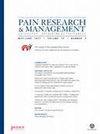Relative Prevalence and Associated Factors of Complex Regional Pain Syndrome Type I in Patients with Radial Head Fractures Treated with Open Reduction and Internal Fixation: A Cross-Sectional Study
IF 2.5
3区 医学
Q2 CLINICAL NEUROLOGY
引用次数: 1
Abstract
Objective This cross-sectional study aimed to examine the incidence and associated factors of complex regional pain syndrome type I (CRPS I) in patients who underwent open reduction and internal fixation (ORIF) for radial head fractures. Methods The study enrolled 601 radial head fracture patients treated with ORIF, 523 of which completed the 1-year follow-up. The incidence of CRPS I in those patients was assessed using the Budapest criteria. Patients were then divided into 2 groups: patients with CRPS I (n = 28) and patients without CRPS I (n = 495). The patients' demographic and clinical data before the operation were prospectively collected by our team. Independent t-tests and χ2 tests were used as univariate analyses to compare the demographic and clinical data between the two groups. Meanwhile, multivariate regression analysis was conducted to identify the associated risk factors for CRPS I. Results The incidence of CRPS I in patients with radial head fractures treated with ORIF was 5.5% during the first year following surgery. Significant differences were observed in age, gender, type of trauma, modified Mason Classification, and depressive personality disorders. The logistic regression analysis revealed that the female gender, modified Mason type III fractures, and depressive patients were significantly more likely to develop CRPS I (p=0.021, 0.023, and 0.025, respectively). Conclusions The incidence of CRPS I among radial head fracture patients undergoing ORIF was 5.5%. In addition, early detection of CRPS I and providing adequate intervention will likely result in greater benefits for those patients.桡骨头骨折切开复位内固定患者I型复杂区域疼痛综合征的相对患病率及相关因素:一项横断面研究
目的本横断面研究旨在探讨桡骨头骨折切开复位内固定(ORIF)患者并发I型复杂区域疼痛综合征(CRPS I)的发生率及相关因素。方法纳入601例经ORIF治疗的桡骨头骨折患者,其中523例完成1年随访。使用布达佩斯标准评估这些患者的CRPS I发生率。然后将患者分为2组:有CRPS I的患者(n = 28)和没有CRPS I的患者(n = 495)。本组对术前患者的人口学及临床资料进行前瞻性收集。采用独立t检验和χ2检验作为单因素分析,比较两组患者的人口学和临床资料。同时进行多因素回归分析,确定发生CRPS I的相关危险因素。结果桡骨头骨折经ORIF治疗后1年内CRPS I的发生率为5.5%。在年龄、性别、创伤类型、改良梅森分类和抑郁型人格障碍方面观察到显著差异。logistic回归分析显示,女性、改良型Mason III型骨折患者和抑郁症患者发生CRPS I的可能性显著增加(p分别为0.021、0.023和0.025)。结论桡骨头骨折行ORIF的CRPS I发生率为5.5%。此外,早期发现CRPS I并提供适当的干预可能会为这些患者带来更大的益处。
本文章由计算机程序翻译,如有差异,请以英文原文为准。
求助全文
约1分钟内获得全文
求助全文
来源期刊

Pain Research & Management
CLINICAL NEUROLOGY-
CiteScore
5.30
自引率
0.00%
发文量
109
审稿时长
>12 weeks
期刊介绍:
Pain Research and Management is a peer-reviewed, Open Access journal that publishes original research articles, review articles, and clinical studies in all areas of pain management.
The most recent Impact Factor for Pain Research and Management is 1.685 according to the 2015 Journal Citation Reports released by Thomson Reuters in 2016.
 求助内容:
求助内容: 应助结果提醒方式:
应助结果提醒方式:


